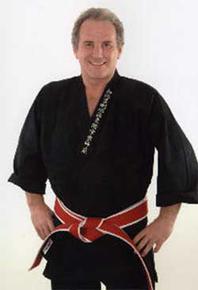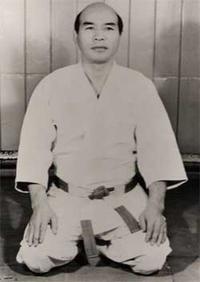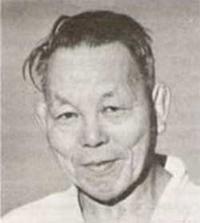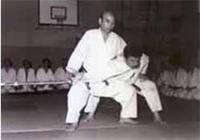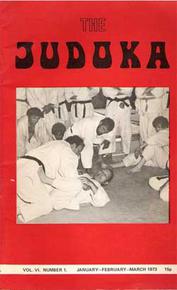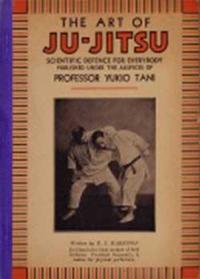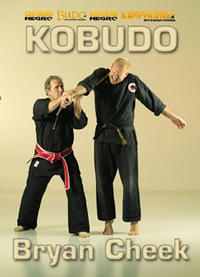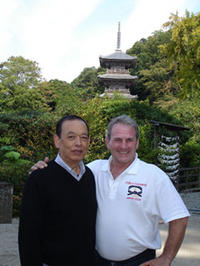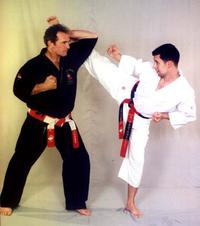He attained his black belt (first dan) in 11 years of trainings in 1969 from his Sensei, Japanese Master Otani Matsuru (1896 - 1977), 8th dan holder. The trainings under Otani Matsuru started in 1964. Having become one of his best English students, Bryan had been training under his lead up to his death in 1977. The last grade, gained from Otani Matsuru, was 4th dan Judo. After that the leadership of «Matsuru Otani Society of Judo» was passed to his son, Robin Otani (the present «British Judo Council» President), who consistently assigned Bryan Cheek 5th and 6th dan Judo.
From 1969 till 1970 Bryan had an opportunity to train under outstanding Japanese Master Kenshiro Abbe (1975 - 1985), the holder of 8th dan in Judo, 6th dan in Kendo, Kudo, Aikido and Karate; Judo champion among 5th dan holders and absolute Japan Champion in year 1933; Ueshiba Sensei (Aikido founder) “uchideshi”. Abbe Sensei was the youngest Judo 3rd, 4th and 5th dan holder and Japan champion in its history (18 years old).
Judo training in «Matsuru Otani Society of Judo» used to be carried out in a traditional manner, with an accent on applied self-defense techniques “goshin jutsu” usage. Initially, Otani Master was teaching Ju Jutsu, then gave prominense to Judo, but remained steady in old methods appliance, even for competitive disciplines. For instance, there was no self-falling during wrestling, except tomoe-nage and yoko sutemi nage. “Makikomi” techniques were excluded at all. Moreover, any throw with a self-falling (except mentioned above) called for a punishment to its performer. Wrist and leg locks, which are absent in sport Judo, were free to use. “Kosen judo” unit was well advanced and that style fights were often practised alongside.
Matsuru Otani himself started Budo trainings in childhood, attending Kendo section at school and practising Ju Jutsu. In 1917 he moved to Ceylon, where had been working for 2 years, and practised Ju Jutsu under Japanese Instructor Seizo Usui. Afterwards he moved to England, where in a year started to train under the first Japanese Kadokan Judo teacher in England. That was Hakoichi Aida Sensei, the student and assistant of Kano Jigoro. Having been training intensively for 5 years, in 1926 Otani became a student, friend and assistant of an outstanding Master - Yukio Tani. Otani was at his side till the day he passed away in 1950. The last grade Otani gained from his Teacher was 4th dan. Then 5th dan Judo he obtained from Ichiro Hata. Only in year 1945 Otani Sensei opened his first Judo club, and in 1948 that club turned into Organisation with its branches. It was also included in the British Judo Association. But in 6 years he would be very disappointed in its sports directedness and, from his point of view, actively propagandised waste of tradition. That is why all the clubs, leading by his followers, left BJA and continued to practise classical style.
In year 1955 Kenshiro Abbe visited London; Matsuru Otani came into close contact with that Master and became his student. Abbe is considered to have 25.000 students in different disciplines during 60’s years.
There are several legends about Kenshiro Abbe. One of them narrates that being 40 years old, while demonstrating his “kyushindo” theory and strength negation in a struggle, he gathered 31 young black belt judokas, who were significantly bigger; having informed which particular techniques he was going to use, carried out 31 fights performing exactly what he was intended to. In year 1937 Abbe fought against legendary Kimura Masahiko. That was the single defeat of Kimura at Judo tatami. Afterwards Kimura commented the fight: “That was like wrestling with a shadow and trying to catch a wind”.
At his trainings in England Abbe Sensei used real “shinken” sword, which used to almost touch a student while performing some form. During his early bushen practice in Japan Abbe would carry out on Saturdays five fights lasting for 25 minutes. That resulted positively, and when before one of the attestation he was to fight against two 2nd dan holders, two 3rd dan holders and one 4th dan holder he was proficient enough to win all the fights in several minutes.
During 1958 Abbe Sensei was widespreading different Budo styles with a great activity. He founded British Judo Council, British Karate Council, British Aikido Council and British Kendo Council in England. All of them are the International Budo Council branches and continue to develop in accordance with “kyushindo” concept - the way of Master Abbe Budo comprehension. In 1959 Otani Sensei, National Trainer of British Judo Union, obtained 7th dan. His elder son, Tomio Otani, was specialising in Kendo, Aikido, Iaido and finally reached 5th dan grade in those arts from Abbe Sensei. He maintains his Teacher’s ideas and “kyushindo” concept. Junior Otani’s son, Robin, pays his attention on Judo.
It is worth to point out that Otani’s objective to change his teaching manner was directly connected with his practice under Kenshiro Abbe, who came to England. Abbe characterized his style as very old, rare and rather interesting for its sportless orientation and recommended him to keep all the old methods, enriching them with modern ones.
In 1960 Abbe Sensei got in a car accident, resulting with serious traumatic brain injury and spinal column injury. But in 1963, in spite of health problems, he participated grandiose Budo performance in Royal Albert Hall. Together with 67 years old Matsuru Otani he demonstrated “kaeshi no kata”. Then he returned to Japan. Only after he had spent a lot of time in Buddhist temple, chanting mantras and sacred texts, he was set free from the disease tormenting the body and consciousness. That happened in 1967 and in 1969 he came back to England. He was extremely astonished with what had happened to the organisation he grounded for 10 years of his absence. He declared that cultivation of the techniques, which were intended to win according IJF rules only, was distorting the essence of Martial Art and his “kyushindo” concepts. That is why he had transformed British Judo Union and appointed Matsuru Otani (who achieved 8th dan) its chairman.
Matsuru Otani regularly, at any age, practising himself “randori” fights, maintained the tradition of his teacher - an eminent Japanese wrestler Yukio Tani, who became famous in Europe for his huge wrestler career, throughout which he was defeated only once by another Japanese Ju Jutsu Master. Yukio Tani is considered to be the founder of European Ju Jutsu. In spite of his 5 foot and 6 inches height, he could fight at a stage without any pause with a number of opponents until all volunteers run low. His manager was well-known in England Barton Wright (the founder of “baritsu” style - the mixture of Ju Jutsu, European fighting and boxing). In 1904 Yukio Tani became an Instructor of British Ju Jutsu Society (London). Soon Tarro Miyaki, Yoshin Ryu Ju Jutsu Master, joined him; hence his school influenced greatly on the organisation development. In 1906 Yukio Tani wrote “Contest in Ju Jutsu” book in co-authorship with Miyaki.
In 1918 a famous Ju Jutsu Master, Gunji Koizumi (Tenshin Shinyo Ryu, Shin Shin Ryu, Akishima Ryu), came to London and opened his Budokwai club; in a year, having received an invitation, Yukio Tani joined him. In 1920, having been visited by Judo founder Kano Jigoro and his student Hakoichi Aida (who stayed in London), Budokwai organisation was redirected to Judo where Yukio Tani and Gunji Koizumi both got 2nd dan. In 1948 Gunji Koizumi founded British Judo Association; most of the British clubs were included to it. The Master died in 1965, committed a suicide. Lots consider him unable to bear that Judo practising in his organisation had turned into something very far from initial Budo concept, which was the sense of his life.
That time Ju Jutsu Masters names were famous not only in Great Britain. In the book “At a dawn of Russian hand-to-hand fighting systems” of Russian author Michail Lukashev, who was specializing in sambo history and hand-to-hand fighting in Russia, there is a very interesting translation of an article regarding a famous English athlete, weight lifting world champion, wrestler and boxer Thomas Inch. There described his fighting with Ju Jutsu Master Raku Uenishi. Regardless of weight advantage almost in 30 kilos, Inch was defeated several times by Japanese Master. At last Inch wrote: “We should state that Uenishi and Tani Yukio won all the best European wrestlers, though Tani Yukio was even smaller then Uenishi”. Yukio Tani and Miyaki names were also emphasized as the best Ju Jutsu Masters in the book of Nil Oznobishin “Hand-to-hand fighting Art”, which was published in Russia in 1930. He also called Yukio Tani “one of the best Japanese champions” and pointed out that famous prize-winners Yukio Tani, Miyaki Taro with other “Japanese Ju Jutsu Professors in London”, being great Masters themselves, were teaching that Art systematically and complete.
Up to his Japanese teacher advice Bryan Cheek opened his first dojo in London in 1972. That “Judo Ippon” club was famous for its rigid old Judo practice; it was rather shameful to win the fight without “ippon” but another mark. Throws with falling were considered to be not correct, as they were dangerous in a real, not sport, fighting. “Kosen judo” wrestling was also practised intensively in the dojo. In spite of specific directedness, lots of “Judo Ippon” students were successful in tournaments, and Bryan Cheek himself became fivefold national Judo champion.
In youth, having achieved Master qualification in Judo, Bryan Cheek began to attend close disciplines trainings and became rather seriously engaged in Ju Jutsu trainings. He’d been training that Art and attesting under the specialist Committee headed by Professor James Blandell (the founder of British Ju Jutsu Association, consequently founded WJJF), Professor Robert Clark and Professor Richard Morris. The name of practising style - “Juko Ryu Ju Jutsu” - was borrowed during the relationships with “Jukokai International” and its leader Rod Socharnosky. At that time relations between Bryan Cheek and Richard Morris became very close, and for a long time they had been working together.
In youth Professor Morris was a leading student of Alf Morgan - one of the first English students of Yukio Tani Sensei. But unfortunately, it is no more information about this person. Morris had been practicing an old style and soon began to study other Martial Art styles and afterwards redirected to Ju Jutsu, becoming one of the most authorative and famous teachers of this Bu Jutsu style. He was influenced greatly by D. Blandell. Till 1986 Richard Morris had been BJJA chairman and WJJF director; then he founded his own organization - “Ju-Jutsu International”. In 1992 he became co-founder of World Kobudo Federation (WKF).
The last grade, which Bryan Cheek gained from Robert Clark in 1993, was 6th dan Ju Jutsu. In 80’s Japanese Master Inoue Tsueshi Munetoshi, the Soke of Hontai Takagi Yoshin Ryu, entered attestative Committee. Since then Bryan Cheek started with traditional Ju Jutsu styles and visited Japan for training. Yasumoto Akiyoshi Sensei was his leading Japanese Ju Jutsu Instructor.
Approximately at the same time, having become “Ju Jutsu International” and “World Kobudo Federation” International Coordinator, Bryan Cheek began to take part actively in establishing a new modern Ju Jutsu syllabus for those organizations. Soon Shihan Cheek became one of the most popular teachers of modern Ju Jutsu in Europe.
In 1996 WKF International Grading Committee, consisted of a number of famous Ju Jutsu and Judo Masters of a high grade, unanimously conferred 7th dan in Ju Jutsu and Judo to Shihan Bryan Cheek.
In 2000 Shihan Cheek left WKF and grounded his own organization - “World Elite Black Belt Society”. Lots of WKF branches separated with him and were included to new organization.
The same year WEBBS Representatives Council, consisting of 50 countries, on a collective basis conferred Shihan Cheek 8th dan.
In 2003, taking into consideration numerous proposals not only WEBBS but all his students worldwide, Shihan Bryan Cheek worked out a complex stylistic system cultivating modern Ju Jutsu, in which were included all the practices and teaching methods gained for years of practice. That unique style got the name of Jukoshin Ryu Ju Jutsu. In that system, as the founder, Shihan Bryan Cheek got 9th dan and Soke status as high merits recognition in modern Ju Jutsu development. That grade was confirmed by lots of amicable organizations.
Today WEBBS unites more then 70 countries and 6 thousands members, approximately 800 of them are black belt holders. Among them more then 5 thousands of Jukoshin Ryu adherents.
Except Judo and Ju Jutsu Bryan Cheek had been training in special hand-to-hand fighting techniques and armed combat. Several times he was invited to carry out training sessions for Special Forces (include government security servise) of Ukraine, Russia, Germany and Canada. Lots of his students are policemen.
Bryan’s sport career was bright - he was fivefold Judo nation champion. His favorite techniques were seoi otoshi, harai goshi, de ashi barai, kataha jime and juji gatame.
In 1994 British Budo Magazine nominated Bryan Cheek for Best British Martial Arts Instructor title.
In 1996 his name was entered into WKF Hall of the Fame.
The same time he was included into World Hall of the Fame (USA, Europe).
Bryan Cheek released a number of DVD - 2 Power Ju Jutsu DVD’s, 3 Ju-Jutsu Syllabus DVD’s, 1 Kobudo DVD and 1 Junior Judo.
Shihan Cheek has published 2 books. One of them, “Ground Control”, was written in co-authorship with Richard Morris and another - “Jukoshin Ryu Ju-Jutsu” - by himself.
Today Bryan Cheek carries out Ju Jutsu and Judo training sessions in his London based dojo and lots of Seminars, World Congresses, tournaments and performances all over the world.
WORLD ELITE BLACK BELT SOCIETY
The current WEBBS president is Soke Yasumoto Akiyoshi, Japan. The founder and chief-instructor is Shihan Bryan Cheek. The organization activity is supervised by five International Coordinators. The next hierarchical stage is national representatives. Then follow the cities Instructors and students.
WEBBS carries out annual World Congresses in the countries where it has its representatives.
JUKOSHIN RYU JU JUTSU by Shihan Bryan Cheek
JUKOSHIN RYU INTERNATIONAL
Bryan Cheek considers the strict comprehension of what you are doing and why you are to do in this very way to be the most important thing for high level trainings.
To his mind, for every Martial Artist it is very important to have a high technique level in his own style, speed, ability to move relaxed, be in a good shape and coordinate body strength with consciousness strength.
Testing (grade qualification) in Jukoshin Ryu is not only the demonstration of technical level but character as well.
«5-S Jukoshin Ryu Ju Jutsu» (5 aspects important for everyone training in Budo)
- Skill
- Speed
- Suppleness
- Stamina
- Strength
Today Jukoshin Ryu keeps on its development with a kind assistance of Jukoshin Ryu International leading Instructors. One part of School syllabus consists of the techniques characterized for traditional Judo, the second - of strokes, and the third - of the techniques characterized for traditional Ju Jutsu. The basic School syllabus consists of 600 separate actions (movements) and combinations, including armed combat techniques. It is divided into syllabus from the beginner to 6th dan grade.
Bryan Cheek and “Bushinkai International”
In autumn 1998, at that time 3rd dan holder, the head of “Bushinkai International” Evgeny Radishevsky visited WKF World Congress in Strasburg, France. At that event he was introduced to the leading WKF Instructors and Chiefs. The same year he together with his student Yury Spivachenko visited WKF headquaters in London for 2 weeks private Ju Jutsu and Judo training session under Hanshi Richard Morris and Shihan Bryan Cheek. During the same training session the English Masters proposed Evgeny Radishevsky to hold a number of trainings for English WKF dojo members. The event happened to be more then successful and “Bushinkai International” was officially recognised by WKF.
Subsequent invitation to visit Ukraine was accepted; in 1999 Organisation International Coordinator, Shihan Bryan Cheek, visited Donetsk and Makeevka with a training Seminar. Intensive trainings, master courses and private sessions had been carrying out for 7 days. Next time Shihan Bryan Cheek visited “Bushinkai” headquarters in Odessa in 2000. He held trainings, grading sessions, a number of master courses and took part in competition judgment.
Some time passed and Shihan Bryan Cheek proposed “Bushinkai” to join WEBBS as a national representative. Thus “Bushinkai” participated the First WEBBS World Congress in Barcelona, where our team won a prize at international ground grappling tournament and participated International performance.
Further relations between WEBBS and “Bushinkai” established fast. In 2005 Evgeny Radishevsky became WEBBS International Coordinator for Eastern Europe, World Grading Panel member and one of 5th leading organization Shihans. In 2006 “Bushinkai” was one of the main organizers of WEBBS Congress in Japan. The same year Shihan Bryan Cheek visited Byelorussia with a tour. There also was organized WEBBS yudansha assembly with a special training courses for Eastern Europe members. In 2009 Cheek visited Ukraine for 7 days intensive training and teaching for the bodyguards of the Government Security Service.
Now our teams participate annual WEBBS Congresses worldwide; Evgeny Radishevsky holds trainings in WEBBS headquarters in London (taking private courses under Shihan Bryan Cheek) and in other countries; “Bushinkai” Instructors and students regularly take part in training sessions to improve.

